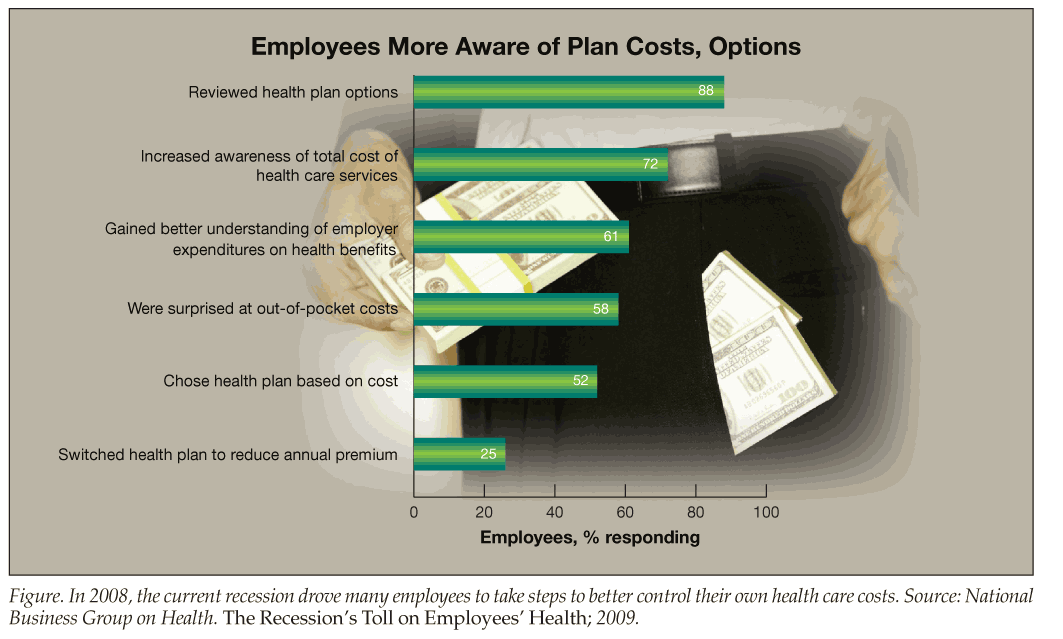Recession Spurs Employees to Examine Health Plan Costs, Adopt Healthy Behaviors
Employees are making changes to improve their health and better control their own health care costs in response to the current recession, according to results of a survey conducted for the National Business Group on Health (NBGH) by Fidelity Consulting Services.
Employees are making changes to improve their health and better control their own health care costs in response to the current recession, according to results of a survey conducted for the National Business Group on Health (NBGH) by Fidelity Consulting Services. About 1500 workers aged 22 to 69 years at large companies (2000 or more employees) who were provided health care benefits through an employer- or union-sponsored health plan were interviewed in March.

The state of the economy has made employees more sensitive to the cost of health care, with nearly three-quarters (72%) reporting that they were more cognizant of the total cost of health care services in the past year (Figure). More than half (56%) of employees said they were more aware of what they pay for health insurance. While 61% of workers reported having a better understanding of what their employer spends on health benefits, two-thirds (67%) said they think their employer has an obligation to provide health benefits. In addition, 68% of workers reported that having access to health benefits is a primary reason for staying with their company.
Nearly all (88%) respondents said they had reviewed their health plan options during their last enrollment period, and about 1 in 4 (24%) said they had switched plans as a result. Of those who changed plans, 25% did so to reduce their annual premium. About half (52%) of respondents said cost determines their choice of a health plan. More than a quarter (27%) of employees reported forgoing treatment to save money on copays or coinsurance costs. About 20% said they had skipped taking a prescription drug, and 17% said they had divided a prescription drug dose in half to make it last longer.
Wellness and prevention were more important to employees in the past year. About two-thirds (66%) of respondents whose employer offers financial incentives said the program had motivated them to lead a healthier life. More than half (52%) of workers indicated that living a healthy lifestyle was more of a priority, 46% said they were eating healthier foods, 44% said they had frequented fast-food restaurants less often, and about one-third (34%) said they had exercised more.
“These data confirm that the widespread economic anxiety is cascading onto individual workers’ health and well-being. At the same time, the data also show that workers are more aligned with businesses about cost concerns and that individuals are taking demonstrable steps to improve their own personal health,” said Helen Darling, NBGH president. The full survey is available at http:// www.businessgrouphealth.org/pdfs/PRESS% 20CONFERENCE-%20RECESSION% 20IMPACT%20ON%20EMPLOYEES% 20052009.pdf.
Pill-Splitting Program Saves $5.5 Million for Health Plan, Members
A pill-splitting program run by HealthPartners, a Minnesota-based HMO, reduced overall costs by $5.5 million in 2007 and 2008. Members who participated in the HealthPartners Half-Tablet Advantage Program saved $1.7 million in out-of-pocket (OOP) costs, and the program cut an additional $3.8 million in HealthPartners’ costs over the past 2 years.
Medications included in the program cost about the same regardless of dosage strength. For example, the cost of a 40-mg tablet of a medication was approximately that of an 80-mg tablet. Physicians prescribed a double-strength dose, and patients split the pills in half. This practice reduced members’ OOP medication expenses by 50%, and employer and health plan costs decreased by 37%. Members were not provided with a tablet splitter but were advised to purchase the inexpensive tool at their pharmacy.
The greatest savings were realized from the use of atorvastatin (Lipitor) and escitalopram (Lexapro). Nearly 6000 HealthPartners members who were taking these 2 medications participated in the pill-splitting program in 2008. Other medications in the program included the generic versions of simvastatin, sertraline, and paroxetine.
Crohn Disease Is Painful for Employers
Researchers led by Edward V. Loftus, MD, associate professor of medicine in the division of gastroenterology and hepatology, Mayo Clinic, Rochester, Minn, found that Crohn disease (CD), which affects half a million US adults, poses a significant economic burden for employers. Findings of the study, funded by Abbott Laboratories, were presented at the Digestive Disease Week meeting held in Chicago from May 30 through June 4.
The team analyzed data on employees enrolled in health care plans at 40 large companies from 1996 to 2007, including information on member eligibility as well as medical, pharmacy, and disability claims. Active employees with moderate to severe CD were included if they had received oral corticosteroids, immunosuppressants, or biologics within 6 months of CD diagnosis. Every CD patient was matched to 3 employees without CD by year of birth, sex, region of residence, and type of employment. Both cohorts were continuously enrolled in a health care plan for 1 year.
Average annual direct costs for the 1279 enrollees with CD were $20,206 compared with $2911 for the 3837 enrollees without the disorder. Employees with CD also had substantially higher average annual indirect costs than those without CD ($3921 vs $1045).